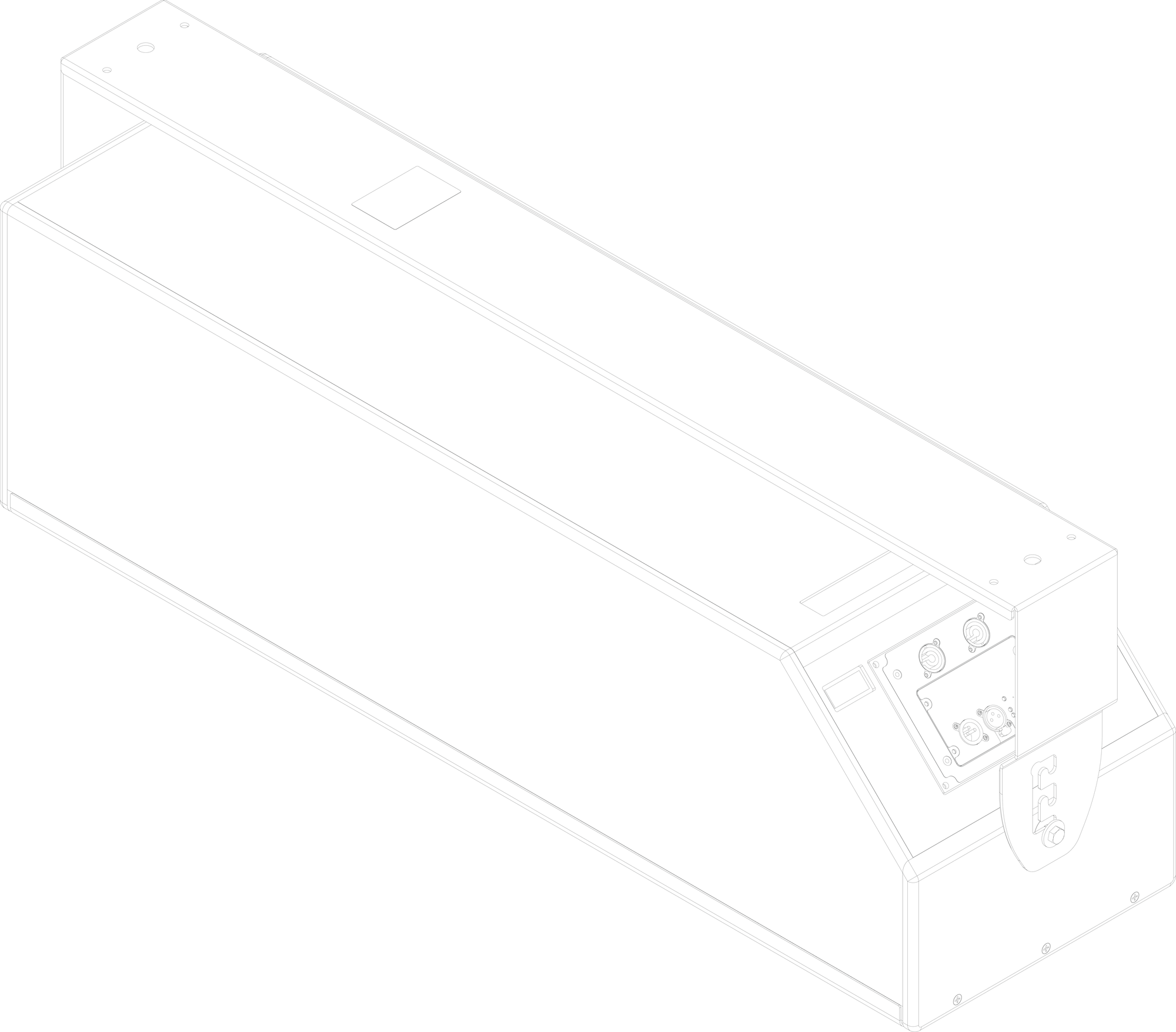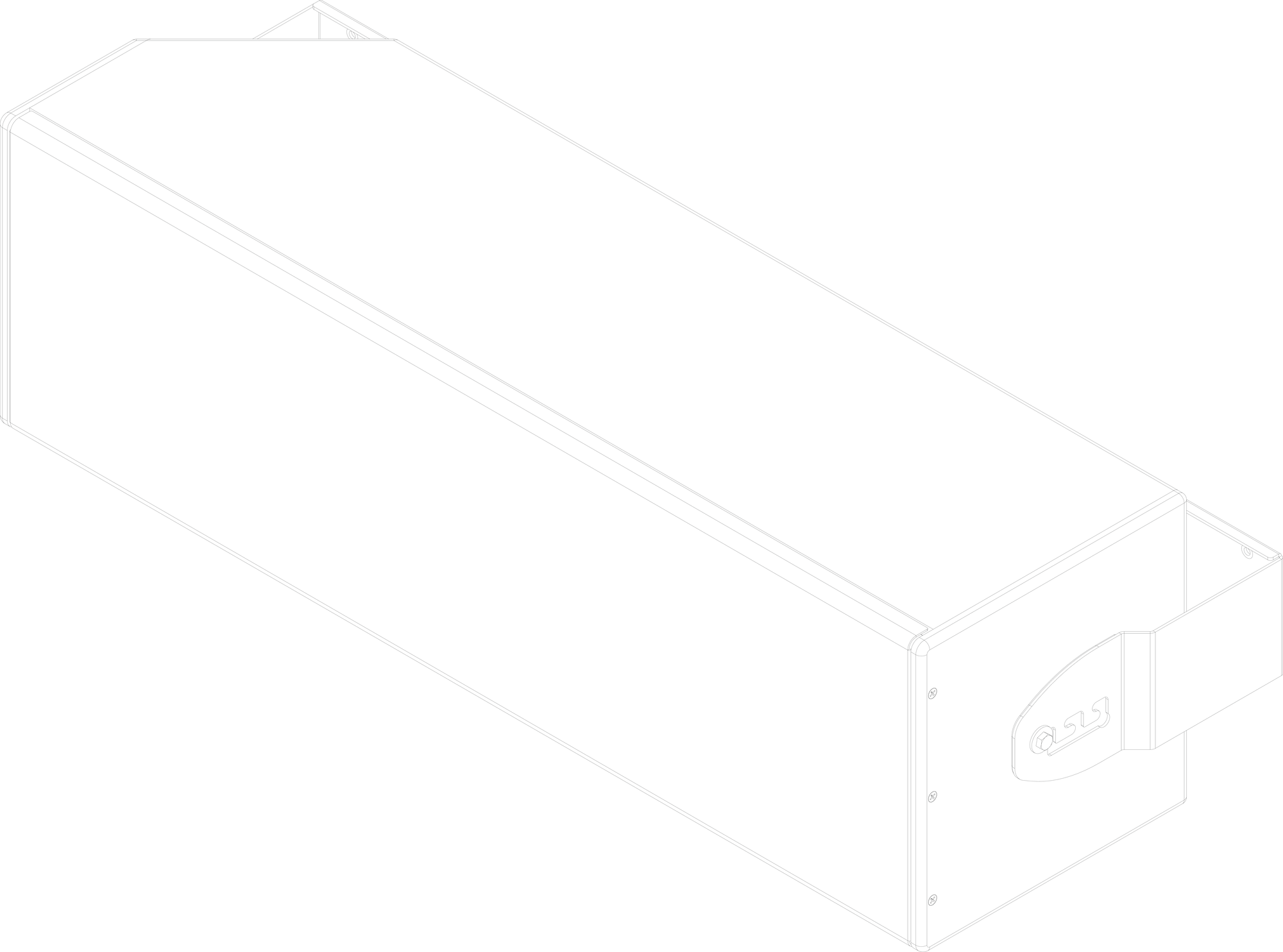Datasheet — USW-210P
Compact narrow subwoofer
 |
 |
USW-210P Loudspeaker and DImensions
The USW-210P compact narrow subwoofer provides robust, extended low frequency response for installed sound applications that require convincing bass impact from a slender, low profile loudspeaker. Its dual-driver configuration permits a narrow form factor that fits into restricted architectural spaces to produce output levels equal to or exceeding systems with single 12-inch (or larger) drivers. Its slanted connector panel enables flush mounting the cabinet against wall surfaces, reducing the required installation depth to 12 inches, including connectors.
The USW-210P is ideal for installations requiring high performance and versatility along with an appealing, discreet aesthetic appearance. The USW-210P integrates easily with Meyer Sound loudspeaker systems, such as CAL™ and ULTRA Series loudspeakers.
The USW-210P has an operating frequency range of 30–140 Hz with a conservatively rated linear peak SPL of 126 dB with crest factor >11.5 dB, measured in half-space at 4 m and referred to 1 m using M-noise3. The long skinny bass reflex cabinet employs the same port design as Meyer Sound’s flagship 1100-LFC low frequency control element for high efficiency and low port distortion.
The cabinet houses a two-channel Class D power amplifier with signal processing including driver protection, and frequency and phase correction.
The Intelligent AC™ power supply provides automatic voltage selection, EMI filtering, soft current turn-on, and surge suppression.
The optional RMS™ remote monitoring system module provides comprehensive, real-time information about loudspeaker parameters from a Mac® or Windows®-based computer running Compass® control software via the RMServer interface.
Meyer Sound constructs the USW-210P cabinet from premium birch plywood coated with a durable black-textured finish and includes a stamped-steel grille to protect the drivers. Weather protection and custom color finishes for specific cosmetic requirements are available options.
With its versatile shape, the USW-210P can be placed on the ground in a horizontal or vertical position to accommodate installation requirements.
The USW-210P comes standard with M8 mounting points at the top and bottom for use with the optional U-bracket that enables wall or ceiling mounting.
In addition, the USW-210P can be securely mounted in a vertical orientation (connectors at top or bottom) using an optional aluminum base plate.
Features and Benefits
High power-to-size ratio
Discrete appearance and versatile, as it accommodates either vertical or horizontal placement
Fits into tight architectural spaces at only 12 inches deep including connectors
Clean and low distortion output due to its low air velocity port
Applications
Commercial installation
Theatrical sound reinforcement
Houses of worship
Conference rooms
High-end home theatre
AV systems
Accessories and Associated Products
MBP-USW-210P Base Plate — Aluminum base plate enhances stability when placing the USW-210P free-standing vertically (connectors at top or bottom).
 |
MBP-USW-210P Base Plate
MUB-USW-210P U-Bracket — U-shaped mounting bracket allows mounting of the USW-210P against a wall or ceiling.
 |
MUB-USW-210P U-bracket (ceiling mount)
 |
MUB-USW-210P U-bracket (wall mount)
Specifications
ACOUSTICAL | |
Operating Frequency Range1 | 30–140 Hz |
Frequency Response2 | 32–123 Hz ±4 dB |
Phase Response | 40–123 Hz ±30° |
Linear Peak SPL3 | 126 dB with crest factor >11.5 dB (M-noise), 126 dB (Pink noise), 127 dB (B-noise) |
Coverage | 360° (single unit), varies with number of units and configuration |
TRANSDUCERS | |
Low Frequency | Two 10-inch cone drivers, nominal impedance 4 Ω |
AUDIO INPUT | |
Type | Differential, electronically balanced |
Maximum Common Mode Range | ±15 V DC, clamped to earth for voltage transient protection |
Connectors | XLR 3-pin female input with male loop output |
Input Impedance | 10 kΩ differential between pins 2 and 3 |
Wiring | Pin 1: Chassis/earth through 1 kΩ, 1000 pF, 15 V clamp network to provide virtual ground lift at audio frequencies Pin 2: Signal + Pin 3: Signal - Case: Earth ground and chassis |
Nominal Input Sensitivity | 0 dBV (1 V rms) continuous is typically the onset of limiting for noise and music |
Input Level | Audio source must be capable of producing a minimum of +20 dBV (10 V rms) into 600 Ω to produce maximum peak SPL over the operating bandwidth of the speaker |
AMPLIFIERS | |
Type | 2-channel (class D) with crossover |
Total Output Power4 | 1800 W peak |
THD, IM, TIM | < 0.02% |
Load | 4 Ω per channel |
Cooling | Convection |
AC POWER | |
Connector | powerCON 20 input with loop output |
Automatic Voltage Selection | Automatic |
Safety Agency Rated Operating Range | 100–240 V AC, 50–60 Hz |
Turn-on and Turn-off Points | 90 V AC turn-on, no turn-off; internal fuse-protection above 265 V AC |
CURRENT DRAW | |
Idle Current | 0.27 A rms (115 V AC); 0.25 A rms (230 V AC); 0.29 A rms (100 V AC) |
Max Long-Term Continuous Current (>10 sec) | 1.4 A rms (115 V AC); 0.7 A rms (230 V AC); 1.6 A rms (100 V AC) |
Burst Current (<1 sec)5 | 4.5 A rms (115 A AC); 2.1 A rms (230 V AC); 4.8 A rms (100 V AC) |
Maximum Instantaneous Peak Current | 9.7 A peak (115 V AC); 4.6 A peak (230 V AC); 10.8 A peak (100 V AC) |
Inrush Current | <20 A peak |
PHYSICAL | |
Dimensions | W: 12.00 in (304.8 mm) x H: 41.33 in (1049.8 mm) x D: 12.00 in (304.8 mm) |
Weight | 56 lb (25.40 kg) |
Enclosure | Premium birch plywood, slightly textured black finish; powder-coated, stamped-steel, protective grille |
Rigging | Top and bottom mounting points with M8 threads |
RMS NETWORK (OPTIONAL) | |
Type | Two-conductor, twisted-pair network that reports all amplifier operating parameters to host computers |
Notes
Recommended maximum operating frequency range. Response depends upon loading conditions and room acoustics.
Measured in half-space with pink noise at 4 meters, 1/3-octave frequency resolution.
Linear Peak SPL is measured in half-space at 4 m referred to 1 m. Loudspeaker SPL compression measured with M-noise at the onset of limiting, 2-hour duration, and 50 °C ambient temperature is <2 dB.
M-noise is a full bandwidth, (10Hz–22.5kHz) test signal developed by Meyer Sound to better measure the loudspeaker’s music performance. It has a constant instantaneous peak level in octave bands, a crest factor that increases with frequency, and a full bandwidth Peak to RMS ratio of 18 dB. The presence of a greater-than (>) symbol with regard to crest factor indicates it may be higher depending on EQ and boundary loading.
Pink noise is a full bandwidth test signal with Peak to RMS ratio of 12.5 dB.
B-noise is a Meyer Sound test signal used to ensure measurements reflect system behavior when reproducing the most common input spectrum, and to verify there is still headroom over pink noise.
Peak power based on the maximum unclipped peak voltage the amplifier will produce into the nominal load impedance.
AC power cabling must be of sufficient gauge so that under burst current rms conditions, cable transmission losses do not cause the loudspeaker’s voltage to drop below the specified operating range.
Architectural Specifications
The loudspeaker shall be a self-powered, sub-bass system. The transducers shall consist of two 10-inch cone drivers. The loudspeaker shall incorporate internal processing electronics and a two-channel amplifier, one channel for each driver. Processing functions shall include driver protection, and frequency and phase correction. Amplifier channels shall be class D. Amplifier output power shall be 1800 W peak total. Distortion (THD, IM, TIM) shall not exceed 0.02%.
Performance specifications for a typical production unit shall be as follows, measured at 1/3-octave resolution: operating frequency range shall be 30 Hz – 140 Hz; phase response shall be 40 Hz – 123 Hz ±30°; linear peak SPL shall be 126 dB with crest factor >11.5 dB, measured in half-space with M-noise at 4 m referred to 1 m. The coverage shall be 360° (single unit).
The loudspeaker shall be equipped with an XLR 3-pin female connector with male loop output. The audio input shall be differential and electronically balanced with 10 kΩ impedance, and a continuous 0 dBV (1 V rms) input signal shall typically drive the speaker to the onset of limiting for noise and music.
Power requirements for the loudspeaker shall be 100–240 V AC, 50-60 Hz. Maximum long-term continuous current draw for the loudspeaker (>10 sec) shall be 1.4 A rms (115 V AC), 0.7 A rms (230 V AC), or 1.6 A rms (100 V AC). The power supply shall provide automatic voltage selection, EMI filtering, soft current turn-on, and surge suppression.
The loudspeaker shall optionally include the RMS remote monitoring system module.
All components shall be mounted in an acoustically vented, box-shaped enclosure constructed of premium birch plywood coated with a durable, black-textured finish. Top and bottom shall incorporate M8 threads. The front protective grille shall be powder-coated, stamped steel.
Dimensions for the loudspeaker shall be W: 12.00 in (304.8 mm) x H: 41.33 in (1049.8 mm) x D: 12.00 in (304.8 mm) without mounting bracket. Weight shall be 56 lb (25.40 kg).
The loudspeaker shall be the Meyer Sound USW-210P.